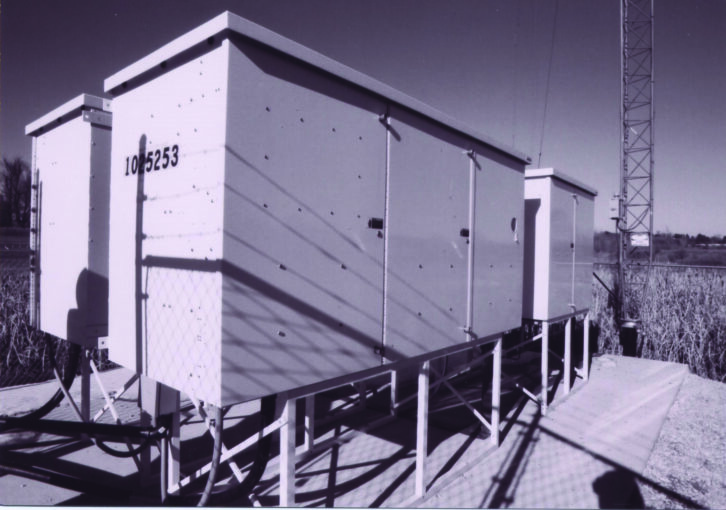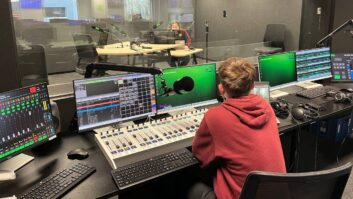
I love AM radio. It’s been a lifelong thing for me, starting when I was a kid and AM was all we had. Then in my teen years, I got a ham license and was fascinated by amplifiers and antennas, and positively intrigued by the arrays of towers in the fields around my hometown.
Once I got inside one of the stations and had a peek at the glowing tubes behind the glass in the transmitter, I was inexorably on my way to a career in broadcast engineering.
Somewhat ironically, my first jobs in radio were at FM stations. They sure didn’t want to give a kid a job on the all-important AM stations, but the FMs, which few people had receivers for anyway, were a good training ground where mistakes could be made with little consequence.
It was really close to 10 years before I did anything at an AM station, having spent those years working mostly in television, but I found I still had a love for AM — and that continues to this day.
With AM somehow part of my genome, I am especially saddened by the state of affairs at many AM stations these days. AM is the victim of progress, among other things — progress in technology and progress in the form of population growth.
I won’t take the time to discuss either of these issues and their various facets in these pages. Instead, I will focus on the options that AM stations and licensees have in today’s challenging environment.
TOO VALUABLE FOR AM
In recent months, I have had discussions with several individuals about AM siting issues. Stations many times lose their land leases or have to sell their land for economic reasons. Landlords and station owners find that the dirt under the AM tower or towers is worth far more for another purpose than as an AM site.
Many times, this news comes with little warning, and stations don’t have a lot of time to find another site. The other side of this double-edged sword is that it isn’t easy to build a tower anymore, even out in the middle of nowhere (I have recent and excruciating experience with this!).
Tighter ASR regulations, in addition to NEPA (National Environmental Protection Act) and NPA (Nationwide Programmatic Agreement) compliance, can add years to the tower approval process. Add to that the state and local environmental, zoning and land use regulations that many venues have in place, and you may find that it will take three or four years just to get all the approvals needed to build — if you can get them at all.
None of that regulatory compliance is cheap. The cost can easily exceed the cost of the tower or towers. The sad economic reality can well be that it’s just not worth it. The earnings potential of the AM station over five or 10 years may not come close to paying for development of the new site. All of that pushes AM station owners to look at other options, one of which may be shutting the station off and turning in the license.
COLLOCATION
“Collocation” is a word that has gained popularity with local regulatory bodies in recent years. I have found that some local planning bodies have the word written into policy or even codified into statute. If an applicant comes to them wanting to build an antenna support structure of any kind, their first question is whether it can be collocated on an existing site. The bar is often set fairly high for this, making collocation a much more attractive route than new construction.
Of course, these rules and policies were written mostly to address the cellular proliferation of the past 20+ years. AM (or any broadcast) use was not even a factor; but a tower is a tower, so AMs get lumped in with the rest and have the same burden of proof as to why they can’t simply hang their little antenna on the side of the 60-foot LTE monopole behind the Wal-Mart.
That being said, it’s a pretty rare thing for an AM station to be the only broadcast outlet in a town, especially in urbanized areas, and that opens up the possibility of some kind of collocation.
[Sign Up for Radio World’s SmartBrief Newsletter]
AM WITH AM
The easiest kind of collocation to do is with another AM station. If the tower is tall enough to present a reasonable impedance and the two stations are sufficiently far apart in frequency (>120 kHz), diplexing two AM stations together is a fairly simple matter of using pass/reject filters on each frequency. Fig. 1 shows cabinets enclosing the needed components.

Even if a tower might otherwise be considered too short for the frequency of the station to be collocated, there are things that can be done to make it work. Reactance can be resonated with shunt components to raise the impedance, and broadbanding networks can sometimes be used to produce a better VSWR bandwidth.
Until February 2016, stations didn’t often have this option. The FCC’s minimum antenna efficiency standards required in most cases for an antenna to produce at least 282 mV/m per kilowatt at 1 km. Fifty-five electrical degrees was about as short as you could go and still meet the standard.
In the FCC’s initial AM Revitalization effort, the minimum antenna efficiency standard was reduced to 215 mV/m per kilowatt at 1 km. Curve A in §73.190, Figure 8 (see reference [1] at the end of the article) only goes down to about 18 electrical degrees (0.05 wavelength), and that corresponds to about 214 mV/m, so presumably a 19-degree antenna would meet the minimum antenna efficiency standard. That really gives stations some options. The lower efficiency could be made up for with transmitter power (and electricity usage).
A station on 600 kHz could, for example, diplex with a station on 1550 kHz that uses a 90-degree (158-foot) tower and still easily meet the minimum antenna efficiency standard.
Of course, we’re talking about non-directional daytime operation here. At night, the vertical plane radiation pattern comes into play, known as the “function of theta.” Short towers are notorious “cloud burners,” radiating a lot of energy well above the horizon. A full-time non-directional AM station that moves from a quarter-wave tower to one that’s 30 or 40 degrees tall will have to reduce power at night to keep from raising the night limits of all the other stations on frequency, particularly those within a few hundred miles.
Can directional stations diplex together? Certainly, if the tower lines and spacing are right for putting the lobes and nulls in the right places. Years ago, I had a 5 kW 1290 kHz station in Portland that diplexed into all three towers of a 50 kW 1520 kHz station. The tower line and spacing were just right and it worked. That kind of thing is rare, however.
How about a non-directional AM diplexing on one tower of another station’s directional array? That’s fairly easy to do, although pass/reject filters and detuning components will be required at the unused towers for the relocated station. It’s also possible to use as a directional antenna just a few towers of another station’s array that has more than that, again provided that the tower line and spacing are right, and again with the understanding that pass/reject filters and detuning components will be required on all the unused towers.
AM ON FM/TV
It’s also possible for an FM or TV (or communications) tower to be used as an AM radiator. The easiest way to do this is to add a set of skirt wires to the tower, insulate the guy wires and plow in a radial ground system. If the tower is fairly tall, the skirt wires may need only go up part of the way, leaving the top part of the tower unencumbered for antenna mounting. Fig. 2 shows two adjacent towers “wearing” a wire skirt.

For many years, I have used Greater Media’s 1,000-foot “Motower” in Detroit for a nighttime site for our 560 kHz station there, seen in Fig. 3. A set of skirt wires runs some distance up the tower and shorts to it at a spot that provides a reasonable impedance at the bottom of the skirt.

Only three ground radials are used for this antenna because of structures and parking lot that occupy what would be the antenna field. Field measurements were made to prove the efficiency of the antenna and determine the input power.
That’s sort of an extreme example, but the point is that it works very well, and we have seldom seen any base impedance change as a result of antenna and transmission line changes on up the tower.
NON-TRADITIONAL ANTENNAS
I would be remiss if I did not mention non-traditional antenna options such as the Kinstar from Kintronic Laboratories (Fig. 4) and the Valcom whip.
The Kinstar uses an array of five short support poles instead of a tower and has been shown to provide good results, an inverse distance field of 300 mV/m/kW, and it is short enough that it may not require any special zoning or local regulatory approval.

The Valcom Whip antenna is a 75- or 85-foot (depending on model) fiberglass whip that’s good for 2 kW input power below 1,000 kHz and 5 kW above. A few years ago, the FCC approved use of the 85-foot Valcom Whip above 1,200 kHz, stating in the public notice that it met the minimum antenna efficiency standard in effect at the time. Presumably, the Valcom could be used on lower frequencies now that the minimum efficiency standard has been lowered.
Either of these options would require a ground system, and a full quarter-wavelength radial system would be best. Still, a low-profile antenna would likely find an easier (and faster) path through the regulatory labyrinth than a full-sized tower.
GROUND SYSTEMS
What happens when an existing station moves to the tower(s) of a higher-frequency station and the ground system is short on the lower frequency? The short answer, no pun intended, is that this is largely taken care of in the new antenna efficiency standards.
The FCC has an unpublished (as far as I know) algorithm that it uses to calculate the inverse distance field of an AM tower with a shortened ground system, based on the average length and number of radials. For example, a 55-degree tower with a full 90-degree 120-radial ground system has an efficiency of 282 mV/m at 1 km per kilowatt. Change the average radial length to 60 degrees and the Curve A efficiency drops to 257 mV/m/kW.
The bottom line with these things is that measurements trump everything (as they did with the Motower example), so if in doubt, if on the edge or off the bottom of the chart, request an STA, temporarily feed the tower on the new frequency and go out and make some measurements in accordance with §73.186. You can then submit those with your application. Measurements would almost certainly be required with a Kinstar or Valcom antenna.
[Subscribe to Radio World Engineering Extra]
COMMUNITY COVERAGE
I should mention the change in the community coverage standards that were also enacted earlier this year. Before the change, AM stations had to produce 5 mV/m coverage of 80 percent or more of the community of license during the day and interference-free coverage in the same percentage of the community at night. That was a real problem for siting AM stations, especially as community boundaries have often grown and available sites are many times a good distance from the town.
This gives existing AMs that are forced to move a lot of options.
In a future article, I will deal with some of the more technical aspects of duplexing: filter design, bandwidth and the like, as well as the use of skirt wires for both diplexing and collocating on non-AM towers.
Until then, if you’re faced with the prospect of an AM site move, keep these options in mind.
REFERENCES
[1] The following is a PDF of Figure 8, §73.190: http://www.ecfr.gov/graphics/pdfs/ec01mr91.079.pdf.
Also, the FCC offers an online calculator of the theoretical inverse distance field strengths in the vicinity of AM broadcast radio stations based on the graphs in Fig. 8 at https://www.fcc.gov/media/radio/figure8.







